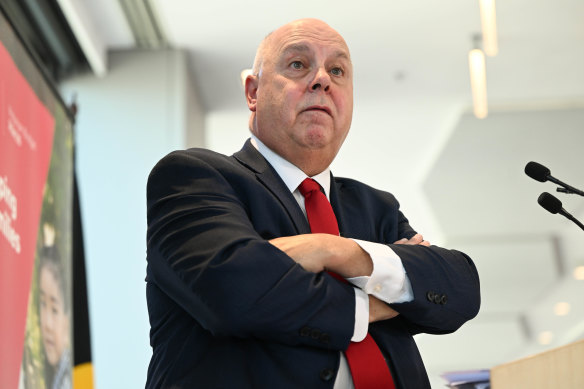- Analysis
- Politics
- Victoria
- Victorian budget
The budget is brimming with hairy-chested spin. But the reality is far more nuanced
By Josh Gordon
The big message from Treasurer Tim Pallas’ 10th budget is that the government is taking hairy-chested fiscal decisions to shore up the state’s financial position as it battles major economic and financial headwinds side by side with Victorian families.
The budget, Pallas said on Tuesday, aimed to tackle two really big problems: high inflation and workforce shortages.

Treasurer Tim Pallas on Tuesday.Credit: Joe Armao
“This is a budget focused on fiscal discipline,” he declared.
Yet if you take the coming financial year as a benchmark – the year that really counts for the purposes of the budget – the reality is far more nuanced.
Just six months ago, the government was predicting the budget would be in deficit by about $1 billion in 2024-25. That expected financial hole has now more than doubled to $2.2 billion.
This extraordinary blowout is more or less entirely of the government’s own design. Its political aim in framing the budget appears to be stacking any financial problems on the budget next year, with a steady improvement in the state’s finances as the 2026 election approaches.
New spending decisions taken since the government budget update in December have, in fact, slashed the bottom line by an extraordinary $3.4 billion in 2024-25.
Another $500 million has been squirrelled away in the hollow log known as the contingency reserve, for future as-yet-unknown spending announcements.
Victoria’s fiscal deterioration in 2024-25 would have been far worse if not for a $1.2 billion GST boost courtesy of the Commonwealth Grants Commission, which in March allocated the state about 97¢ of GST revenue for every $1 it pays in 2024-25, up from just 85¢ for the current financial year.
Nor is the Allan government holding back when it comes to the tax take. In fact, estimates for the tax haul in 2024-25 have been upgraded by $701 million since Treasury’s December budget update.
The government is expected to rake in $8.5 billion worth of stamp duty – up from an earlier prediction of $8.1 billion – while land taxes are expected to reap $6.5 billion. In other words, property taxes are rising rapidly, despite higher interest rates.
Several taxes and levies will increase. The state’s waste levy will be harmonised with NSW and South Australia, raising a whopping $423 million over the next three years. There will also be new rules for the fire services levy that will raise about $591 million over four years, including $166.3 million next year.
There are some savings in the budget, collectively worth $297.5 million in 2024-25, including winding up the government’s sick pay guarantee, cutting the public sector’s office space budget and reducing government advertising.
But more broadly, if there are tough decisions, they will benefit the state’s finances in coming years, including decisions to delay or scrap various major projects and spending programs.
As a consequence, for the first time since 2018-19 – assuming everything goes to plan – the budget will be back in surplus by $1.5 billion in 2025-26, rising to $1.9 billion by 2027-28.
That will allow the government to finally pay down its borrowings, with net debt set to peak, stabilise and then decline in proportional terms.
Treasury predicts net debt will rise from about 22.3 per cent of the state economy currently to 25.2 per cent by the middle of 2027, before finally edging back by a wafer-thin 0.1 of a percentage point to 25.1 by the middle of 2028.
Even with this modest proportionate improvement, in dollar terms debt is going to keep rising from about $135.9 billion to $187.8 billion by mid-2028, providing an annual interest bill of $9.4 billion. That would represent a 44 per cent increase over four years, making annual borrowing costs the fastest-growing big expense item in the budget.
RMIT emeritus professor David Hayward said the government had taken a gamble that cash-strapped families would focus on the increased spending – including bonus payments to cover education expenses – and would be less concerned about abstract debt and deficit numbers.
“That may well be a good bet as long as the economy keeps bubbling along,” he said. “If it doesn’t, it could be a different story.”
There are also some major structural challenges facing the budget that have – presumably – been kicked down the road. Stamp duty, for example, now makes up about 22 per cent of Victoria’s total tax haul, yet it is frequently derided as Australia’s least efficient tax while being blamed for exacerbating the state’s housing affordability crisis.
Pallas has hinted he is open to reform, including potentially giving home buyers the option of paying an ongoing land tax instead. But so far, the government has said little about how this could be achieved.
If the government is serious about tackling the state’s housing affordability crisis and genuinely “helping families” it will need to get on with the job of introducing further planning and tax reforms to genuinely assist first-home buyers.
Yet the budget had little to say about these and other economic reforms that will surely be needed to tackle growing imbalances and inequities that will only become more acute as the state’s population approaches 10 million people.
In this sense, Jacinta Allan’s first budget as premier, and Pallas’ 10th as treasurer, represents a wasted opportunity.
Get the day’s breaking news, entertainment ideas and a long read to enjoy. Sign up to receive our Evening Edition newsletter here.